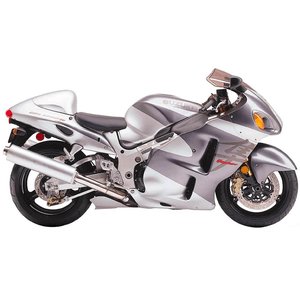Suzuki GSX 1300 R Hayabusa (2016–2020): The Icon Reimagined
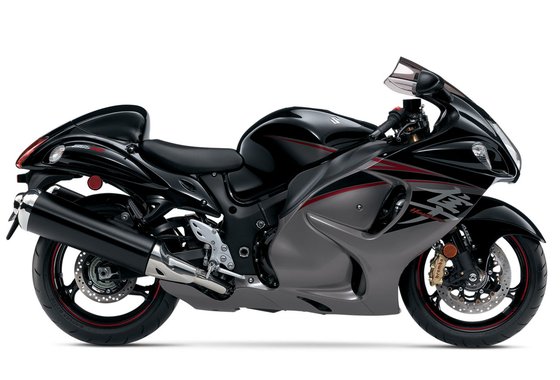
Introduction
The Suzuki Hayabusa isn’t just a motorcycle—it’s a legend. From its debut in 1999, this machine has been synonymous with speed, power, and aerodynamic dominance. The 2016–2020 generation refined the formula further, blending its raw, falcon-inspired aggression with modern engineering finesse. Having thrown a leg over a 2020 model for a spirited ride, it’s clear why the Hayabusa remains a bucket-list bike. This isn’t just about chasing top speeds; it’s about owning a piece of motorcycling history that still feels thrillingly relevant today.
Design & Aerodynamics
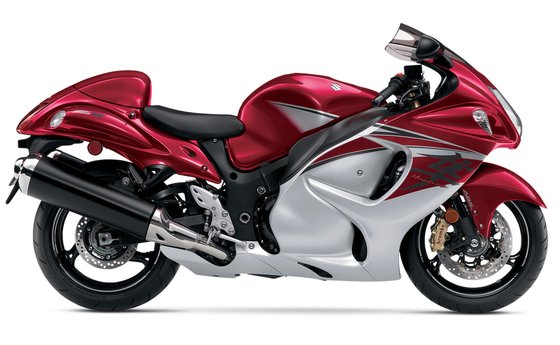
The Hayabusa’s design hasn’t strayed far from its original ethos: function shapes form. The vertically stacked headlights, a signature since the first generation, slice through the air with purpose, flanked by a ram-air intake that feeds the beastly 1340cc engine. The fairing isn’t just for show—extensive wind tunnel testing ensures stability at triple-digit speeds, while the rider stays cocooned in a bubble of calm.
Suzuki offered this generation in bold color schemes like Candy Daring Red and Metallic Thunder Gray, with glossy finishes that highlight the bike’s muscular curves. The minimalist windscreen drew mixed reactions—it’s adequate for highway cruising but leaves taller riders wishing for an aftermarket upgrade. At 2190 mm (86.2 inches) long and 735 mm (28.9 inches) wide, the Hayabusa has a road presence that borders on intimidating, yet its 805 mm (31.7-inch) seat height remains accessible for riders of average stature.
Engine & Performance
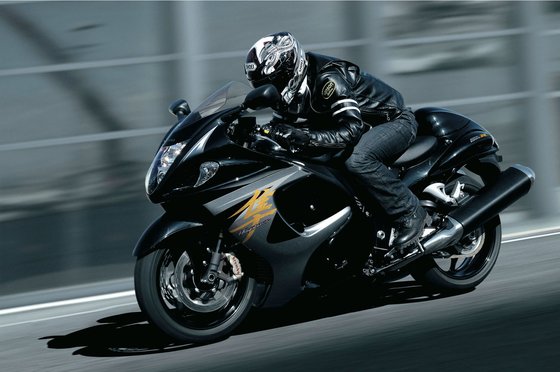
The heart of the Hayabusa is its 1340cc inline-four engine, a masterpiece of controlled fury. With 197 HP (143.8 kW) at 9,500 RPM and 155 Nm (114.3 lb-ft) of torque at 7,200 RPM, acceleration is relentless. Throttle response is crisp, thanks to Suzuki’s Dual Throttle Valve (SDTV) system, which uses twin injectors per cylinder for precise fuel delivery.
Twist the grip, and the Hayabusa surges forward with a deep, metallic growl. The 0–100 km/h (0–62 mph) sprint takes 3.0 seconds, but it’s the midrange punch that astonishes—overtaking at highway speeds feels effortless. The engine’s Twin Swirl Combustion Chambers and lightweight titanium valves ensure efficiency, while liquid cooling keeps temperatures in check even during spirited rides.
The Suzuki Drive Mode Selector (S-DMS) offers three riding modes:
- Mode A (Active): Full power with aggressive throttle response.
- Mode B (Basic): Smoother delivery for wet roads or casual riding.
- Mode C (Comfort): Reduced power for fuel efficiency.
In practice, Mode A is addictive, but Mode B strikes the best balance for everyday use. The six-speed transmission shifts seamlessly, aided by the Suzuki Clutch Assist System (SCAS), which lightens lever effort and mitigates rear-wheel hop during aggressive downshifts.
Handling & Ride Experience
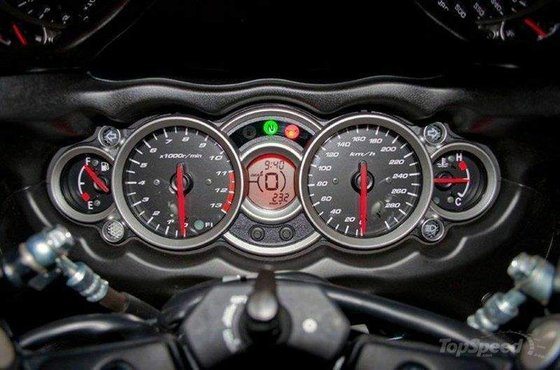
At 266 kg (586 lbs) wet, the Hayabusa isn’t a featherweight, but its twin-spar aluminum frame and 1480 mm (58.3-inch) wheelbase inspire confidence. The KYB inverted forks—coated with Diamond-Like Carbon (DLC) to reduce friction—and fully adjustable rear suspension handle everything from canyon carving to long highway slogs.
Push it into a corner, and the Bridgestone BT-015 tires (120/70-ZR17 front, 190/50-ZR17 rear) grip tenaciously. The steering is heavier than a supersport bike, but that heft translates to stability at speed. Brembo’s Monobloc calipers bite down on 310 mm dual front discs with authority, while ABS intervenes subtly to prevent lockups.
The riding position is a compromise: slightly leaned forward, with narrow handlebars that encourage aggressive steering. After an hour in the saddle, wrists and shoulders might protest, but the seat itself is surprisingly plush for a sport-focused machine.
Technology & Features
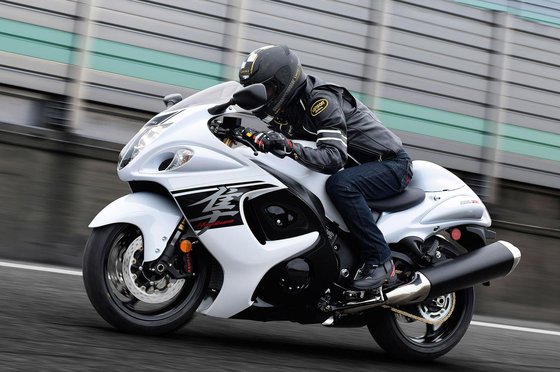
The Hayabusa’s analog-digital dash feels delightfully retro in an era of TFT screens. The tachometer and speedometer are flanked by an LCD panel displaying gear position, fuel economy, and trip data. It’s functional, if not flashy.
Key tech highlights include:
- Anti-lock Braking System (ABS): Standard across all years.
- Slipper Clutch: Prevents rear-wheel chatter during rapid downshifts.
- Idle Speed Control (ISC): Simplifies cold starts and stabilizes idle.
The vertically stacked LED headlights provide excellent nighttime visibility, though the low beam’s 55W H7 bulb feels dated next to modern LEDs.
Competition
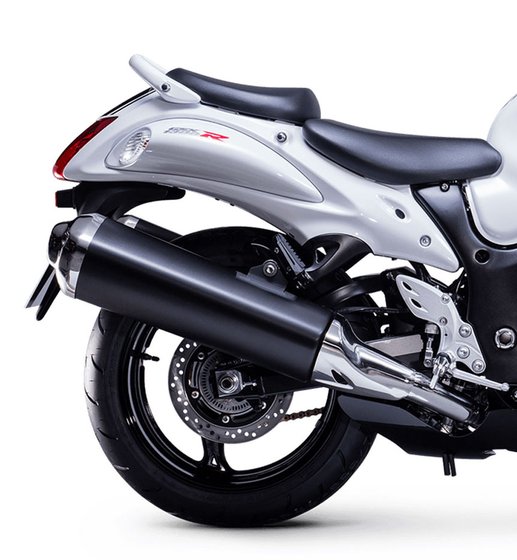
The Hayabusa’s closest rival is the Kawasaki Ninja ZX-14R, which matches its displacement but edges ahead in peak torque (162 Nm vs. 155 Nm). The ZX-14R’s ergonomics are more touring-friendly, but the Hayabusa counters with sharper handling and Brembo brakes.
In the liter-bike arena, the BMW S 1000 RR and Honda CBR1000RR offer lighter weights and advanced electronics (e.g., wheelie control, cornering ABS). However, neither can replicate the Hayabusa’s visceral, hyperbike-level thrust. The Suzuki’s ace is its versatility—it’s equally at home devouring highways or dominating drag strips.
Maintenance
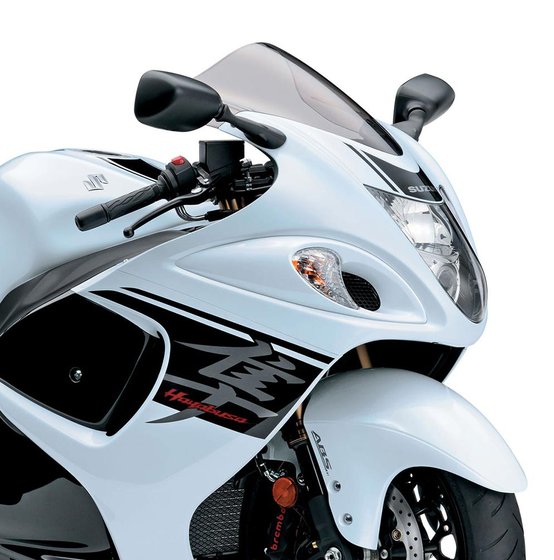
Ownership costs are reasonable for a bike of this caliber, but neglect isn’t an option. Key maintenance tips:
1. Oil Changes: Every 6,000 km (3,700 miles) using SAE 10W-40 (3.3L with filter).
2. Valve Inspections: Every 24,000 km (15,000 miles). Clearances: 0.08–0.18 mm (intake), 0.18–0.28 mm (exhaust).
3. Chain Care: Clean and lubricate every 500 km (310 miles). Stock chain: RK GB50GSV Z4 (114 links).
4. Coolant: Replace every 2 years (3.0L capacity).
5. Tire Pressure: 2.9 bar (42 psi) front/rear for optimal grip.
Upgrading to aftermarket parts can enhance performance:
- Exhaust: Swap the stock system for a Yoshimura Hepta Force titanium setup (as seen on the Hayabusa Z variant) to shed weight and amplify the engine’s roar.
- Windscreen: A taller screen from MOTOPARTS.store improves long-distance comfort.
- Brake Pads: Sintered pads offer better bite during aggressive braking.
Conclusion
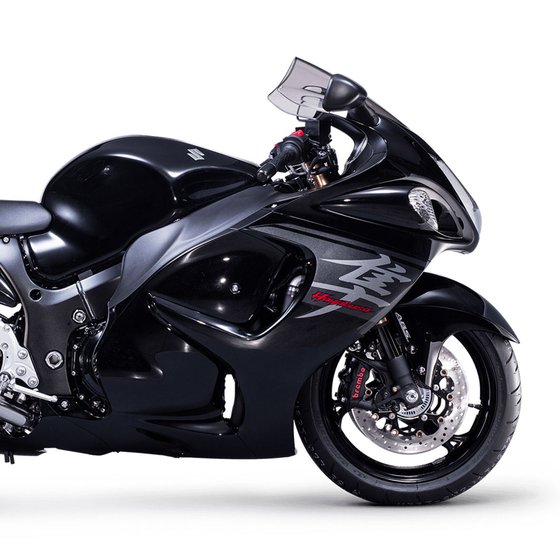
The 2016–2020 Suzuki Hayabusa is a paradox—a 20-year-old design that still feels cutting-edge. It’s not the lightest or most tech-laden bike in its class, but its combination of brutal acceleration, rock-solid stability, and iconic styling is unmatched. For riders who crave a machine that dominates both the road and the imagination, the Hayabusa delivers.
And when it’s time to personalize or maintain your falcon, MOTOPARTS.store has the upgrades and OEM-quality components to keep it soaring.
Fly fast. Fly fearless.
Specifications sheet
| Engine | |
|---|---|
| Stroke: | Four-stroke |
| Max power: | 144 kW | 193.0 hp |
| Max torque: | 155 Nm |
| Fuel system: | Fuel Injection (SDTV 44 mm throttle bodies) |
| Max power @: | 9500 rpm |
| Displacement: | 1340 ccm |
| Max torque @: | 7200 rpm |
| Bore x stroke: | 81.0 x 65.0 mm (3.2 x 2.6 in) |
| Configuration: | Inline |
| Cooling system: | Liquid |
| Compression ratio: | 12.5:1 |
| Number of cylinders: | 4 |
| Valves per cylinder: | 4 |
| Dimensions | |
|---|---|
| Wheelbase: | 1480 mm (58.3 in) |
| Dry weight: | 220 |
| Wet weight: | 266 |
| Seat height: | 805 mm (31.7 in) |
| Overall width: | 735 mm (28.9 in) |
| Overall height: | 1165 mm (45.9 in) |
| Overall length: | 2190 mm (86.2 in) |
| Ground clearance: | 120 mm (4.7 in) |
| Fuel tank capacity: | 21 L (5.5 US gal) |
| Drivetrain | |
|---|---|
| Final drive: | chain |
| Gear ratios: | 1st 1.596 / 2nd 2.615 / 3rd 1.937 / 4th 1.526 / 5th 1.136 / 6th 1.086 |
| Chain length: | 114 |
| Transmission: | 6-speed, constant mesh |
| Rear sprocket: | 43 |
| Front sprocket: | 18 |
| Final drive ratio: | 2.388 (43/18) |
| Primary drive ratio: | 1.596 (83/52) |
| Maintenance | |
|---|---|
| Rear tire: | 190/50-z-17 |
| Engine oil: | 10W40 |
| Front tire: | 120/70-z-17 |
| Brake fluid: | DOT 4 |
| Spark plugs: | NGK CR9EIA-9 |
| Spark plug gap: | 0.9 |
| Coolant capacity: | 3.0 |
| Forks oil capacity: | 1.1 |
| Engine oil capacity: | 3.3 |
| Chain lubrication interval: | Every 500 km (310 mi) |
| Engine oil change interval: | Every 5000 km or 2 years |
| Valve clearance (intake, cold): | 0.08–0.18 mm |
| Valve clearance check interval: | 24,000 km (15,000 mi) |
| Valve clearance (exhaust, cold): | 0.18–0.28 mm |
| Recommended tire pressure (rear): | 2.9 bar (42 psi) |
| Recommended tire pressure (front): | 2.9 bar (42 psi) |
| Additional Features | |
|---|---|
| Lighting: | Vertically stacked H9/H7 headlights |
| Warranty: | 12-month unlimited mileage |
| Drive modes: | S-DMS (3 selectable engine maps) |
| Instrumentation: | Analog gauges with LCD panel (gear position, S-DMS mode, odometer) |
| Chassis and Suspension | |
|---|---|
| Rake: | 24.2° |
| Frame: | Twin-spar aluminum alloy |
| Trail: | 98 mm (3.8 in) |
| Rear brakes: | Single 260 mm disc, Nissin 1-piston caliper (ABS) |
| Front brakes: | 2 x 310 mm discs, Brembo 4-piston radial calipers (ABS) |
| Rear suspension: | Link-type monoshock, fully adjustable (preload, compression, rebound damping) |
| Front suspension: | KYB inverted telescopic fork, fully adjustable (preload, compression, rebound damping) |
| Rear wheel travel: | 140 mm (5.5 in) |
| Front wheel travel: | 120 mm (4.7 in) |



